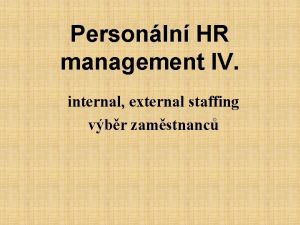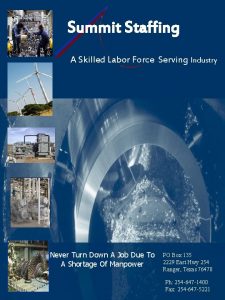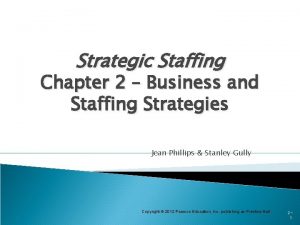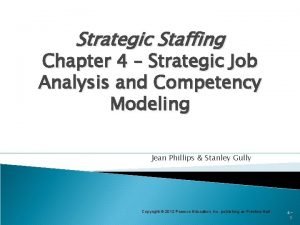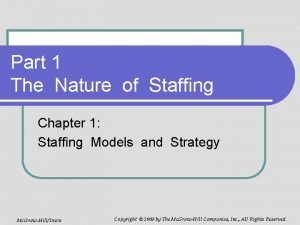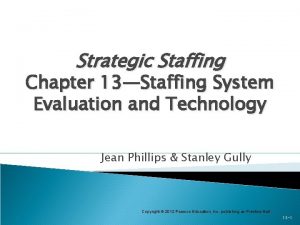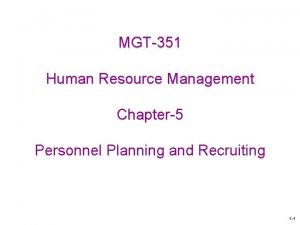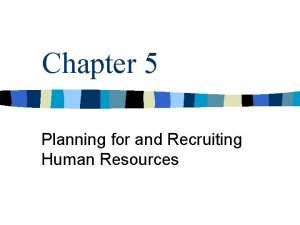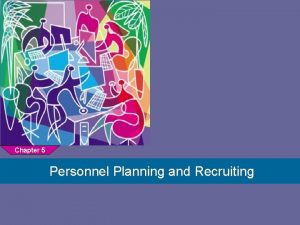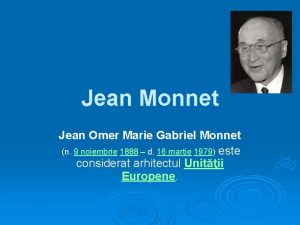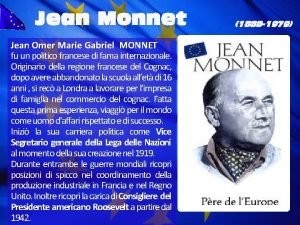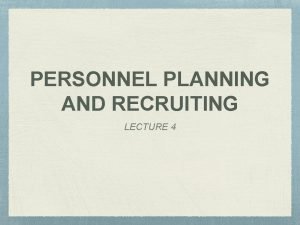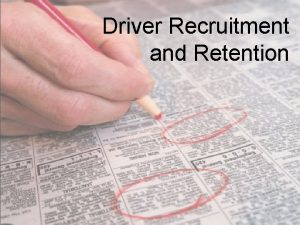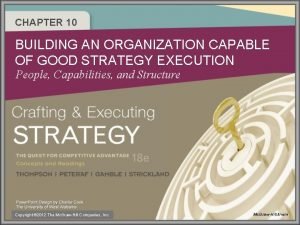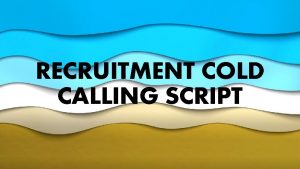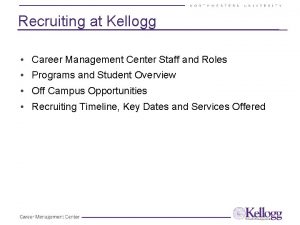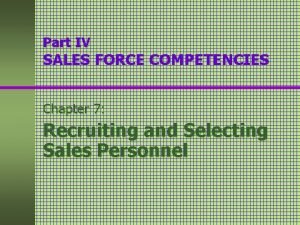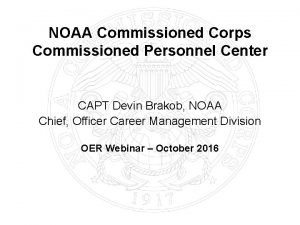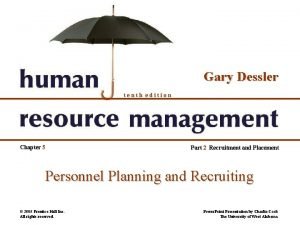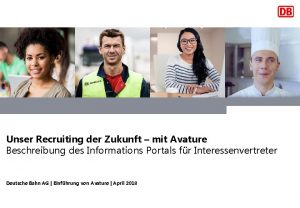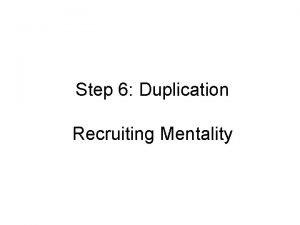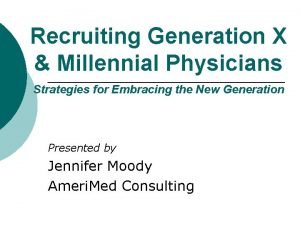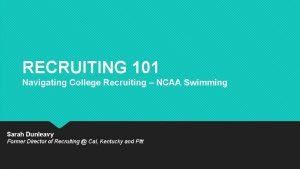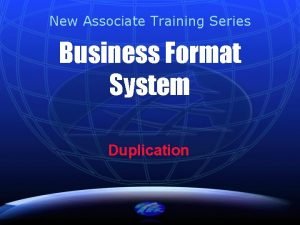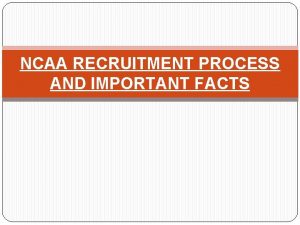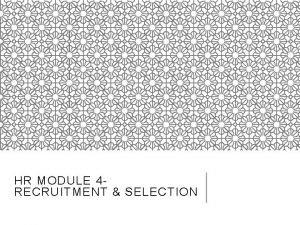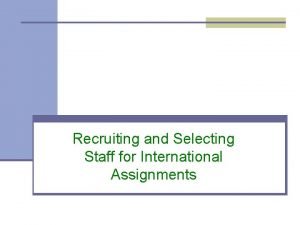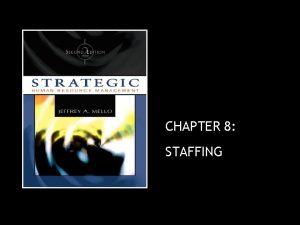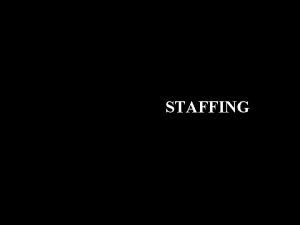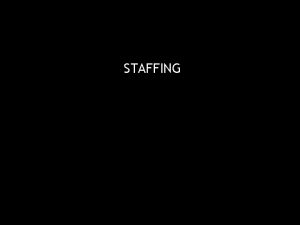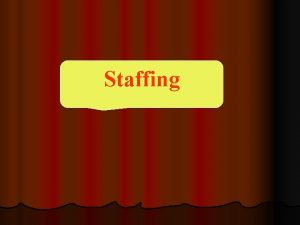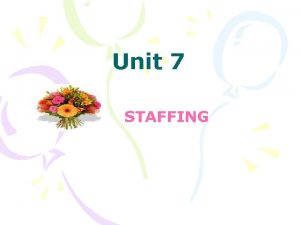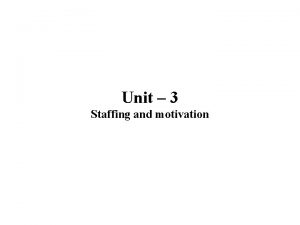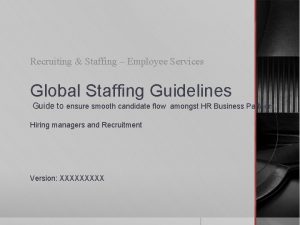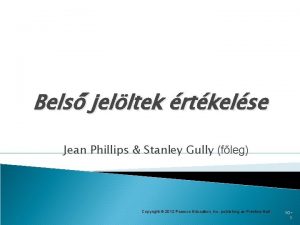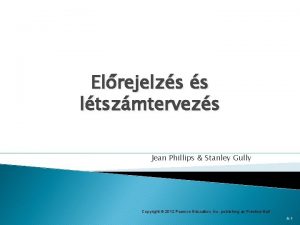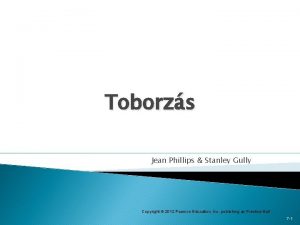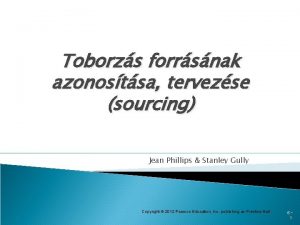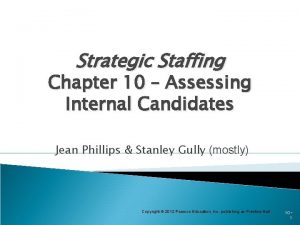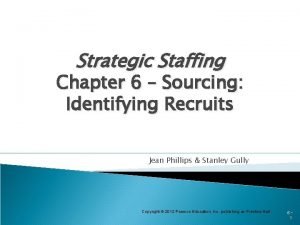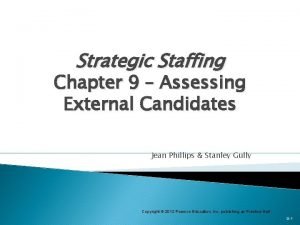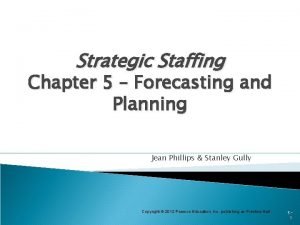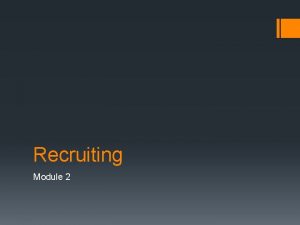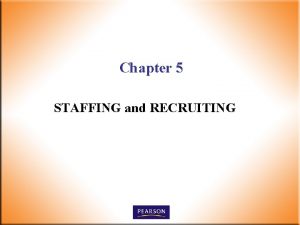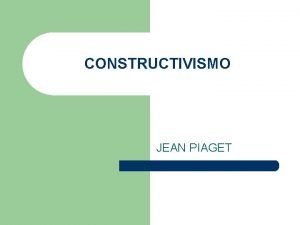Strategic Staffing Chapter 7 Recruiting Jean Phillips Stanley
































- Slides: 32

Strategic Staffing Chapter 7 – Recruiting Jean Phillips & Stanley Gully Copyright © 2012 Pearson Education, Inc. publishing as Prentice Hall 71

Recruiting Definition: activities that convert the leads generated during sourcing into job applicants, generate interest in a company and its jobs, and persuade candidates to accept extended job offers ◦ Can be done by recruiters, hiring managers, or employees Copyright © 2012 Pearson Education, Inc. publishing as Prentice Hall 72

Applicant Reactions An important goal of recruitment is to give every applicant a positive feeling about the organization Organizational and individual perspectives are both relevant ◦ Effective recruitment requires considering the applicant’s perspective and needs ◦ Both parties are pursuing a business relationship Copyright © 2012 Pearson Education, Inc. publishing as Prentice Hall 73

Three Types of Fairness Distributive: the perceived fairness of the hiring or promotion outcome ◦ Did you get the job or promotion? Procedural: beliefs that the policies and procedures that resulted in the hiring or promotion decision were fair ◦ Respect applicants’ privacy, avoid delays, use job -related assessments, give fair opportunity to perform Interactional: fairness of the interpersonal treatment and amount of information received during the hiring process ◦ Honesty, respect, recruiter warmth, and informativeness Copyright © 2012 Pearson Education, Inc. publishing as Prentice Hall 74

Spillover Effects Definition: indirect or unintended consequences of an action Most job candidates do not get the job or promotion – so what happens next? ◦ If they were forced to wait extended periods for pre-scheduled interviews, met unprepared and distracted interviewers, felt that the selection process was unfair, and were not made to feel important or welcome, will they still fly your airline or buy your products? Apply for another job with you in the future? Tell their friends and family how impressed they were with your firm and influence them to become customers or job applicants? Copyright © 2012 Pearson Education, Inc. publishing as Prentice Hall 75

Spillover Effects What if they were greeted by name, given a quick tour of the facility, treated fairly and respectfully, interviewed on time by prepared and enthusiastic employees, and heard from the company when it said it would follow up? Many firms treat job candidates as if they should feel privileged the firm is even considering them for a position, and treat rejected candidates as if that was the end of their relationship. This is simply not the case. Copyright © 2012 Pearson Education, Inc. publishing as Prentice Hall 76

Recruitment Continues Until either the organization (or the candidate) removes the person from further consideration, or the individual is hired and reports for work, it is the job of recruiting to keep him or her interested in pursuing the opportunity with the organization. Recruiters should help candidates continually feel excited about the opportunity and ultimately be willing to accept a reasonable job offer. The effects of an organization’s actions and reputation on applicant attraction begin before an organization ever advertises an open position and continue after the position is filled. Copyright © 2012 Pearson Education, Inc. publishing as Prentice Hall 77

Desirable Recruiter Characteristics Familiarity with the job and organization Good listening skills Good communication skills Good social skills Intelligence Self-confidence Extroversion Enthusiasm about the job and company Trustworthiness Credibility Copyright © 2012 Pearson Education, Inc. publishing as Prentice Hall 78

Signaling Because people often have limited information about organizations and jobs, in the absence of objective information they may rely on the recruiter’s traits and behaviors as signals of aspects of both the company and the job opportunity. ◦ A CEO involved in recruiting may signal a job’s importance ◦ A demographic minority recruiter may signal the firm’s demographic diversity Recruiter behaviors affect applicant attraction indirectly through influencing applicant perceptions of job and organizational attributes. Copyright © 2012 Pearson Education, Inc. publishing as Prentice Hall 7 -9

Who Should Recruit? Internal recruiters External recruiters Employees Hiring managers Recruiter profiles The recruiter should be someone who can relate to a targeted recruit and persuade him or her to apply and/or accept a job offer Copyright © 2012 Pearson Education, Inc. publishing as Prentice Hall 710

Factors Influencing Recruiter Effectiveness Copyright © 2012 Pearson Education, Inc. publishing as Prentice Hall 7 -11

Recruiter Training Recruiter knowledge Interpersonal skills Presentation skills Cultural skills Organizational goals and recruiting objectives Legal issues Multiple assessments Applicant attraction Copyright © 2012 Pearson Education, Inc. publishing as Prentice Hall 7 -12

Recruiting metrics New hire job performance New hire failure rate Turnover of hew hires Manager satisfaction New hire time to productivity Training success Copyright © 2011 Pearson Education, Inc. Publishing as Prentice Hall 1 -13

Recruiter Goals & Feedback An organization usually has specific goals for recruiter activities including: ◦ Employer branding ◦ Candidate screening ◦ Generating candidates’ interest For a recruiter to pursue the organization’s goals: ◦ The organization’s goals must be known by the recruiter and be consistent with the recruiter’s personal goals ◦ The recruiter must receive feedback in relation to these goals Copyright © 2012 Pearson Education, Inc. publishing as Prentice Hall 7 -14

Recruiter Incentives The behaviors and outcomes that are rewarded are the ones most likely to be pursued by recruiters Align rewards with staffing goals Balance long-term and short-term goals Balance team and individual goals Copyright © 2012 Pearson Education, Inc. publishing as Prentice Hall 715

Organizational Image Definition: a general impression based on both feelings and facts. ◦ What comes to mind when you think of Nieman-Marcus, Goldman Sachs, and Tiffany’s? The more favorable a company’s image, the more people are likely to consider the organization attractive as an employer and state a willingness to respond to its recruitment advertisements. Organizational images differ across subgroups of individuals. Copyright © 2012 Pearson Education, Inc. publishing as Prentice Hall 7 -16

Employer Image Definition: attitudes toward and perceptions of the organization as an employer Employer brands reinforce the employer image: ◦ Johnson & Johnson: “Small Company Environment, Big Company Impact” ◦ Eli Lilly: “Innovation Has a Face: Our People” ◦ Medtronic: “Careers with a Passion for Life” ◦ Abbott Labs: “Inspired to Achieve. Make a Difference in Your World” ◦ Sharp: “From Sharp Minds Come Sharp Products” Copyright © 2012 Pearson Education, Inc. publishing as Prentice Hall 7 -17

Employer Image How an organization is reputed to treat applicants and employees is likely to have a particularly strong effect on applicant attraction. Newer or lesser-known organizations with weak or nonexistent images among job seekers may have greater difficulty attracting recruits using passive recruitment sources such as newspaper advertisements than organizations that are more widely known and favorably thought of. Copyright © 2012 Pearson Education, Inc. publishing as Prentice Hall 718

Nature of the Recruiting Message Different types of recruiting materials are used to attract the attention of potential applicants and induce them to apply Message content should appeal to the goals and values of the targeted recruits Noncompensatory screening factors should be communicated to facilitate self-selection ◦ The job’s location, the type of job, pay, etc. Copyright © 2012 Pearson Education, Inc. publishing as Prentice Hall 7 -19

Realistic Job Previews Definition: provide both positive and potentially negative information to job candidates. Rather than trying to sell the job and company by presenting the job opportunity in the most positive light, realistic job previews strive to present an honest and accurate picture. The goal is not to deter candidates by focusing on factors that might be perceived negatively, but to provide objective information that job candidates can use to self-assess their fit with the job and organization. Functions: self-selection, vaccination, commitment to the coice Copyright © 2012 Pearson Education, Inc. publishing as Prentice Hall 7 -20

Self-Assessment Tools Perceiving a good fit with a company’s culture and job opportunities improves a job seeker’s attraction to the organization Bad fits self-select out Self-assessments should be anonymous and not used for selection Online self-assessments Copyright © 2012 Pearson Education, Inc. publishing as Prentice Hall 721

Timing of Information Copyright © 2012 Pearson Education, Inc. publishing as Prentice Hall 7 -22

Recruitment Consistency Recruiting guide ◦ A formal document that details the process to be followed in recruiting for an open position. ◦ Addresses both internal and external recruiting processes. ◦ Clarifies company policies and procedures relating to appropriate budgets, activities, timelines, responsible staff, legal issues, and the specific steps to be taken in recruiting for the position. ◦ Helps to standardize the recruiting procedures used by the organization, clarify which employees are expected to perform what roles during the recruitment process, and helps to ensure that all of the relevant recruiting policies and procedures are followed during the recruitment process. Copyright © 2012 Pearson Education, Inc. publishing as Prentice Hall 7 -23

EEOC Best Practices in Recruiting Establish a policy for recruiting and hiring, including criteria, procedures, responsible individuals, and applicability of diversity and affirmative action initiatives. Engage in short-term and long-term strategic planning. Identify the applicable barriers to equal employment opportunity. Specify the firm’s recruiting goals. Make a road map for implementing the plan. Copyright © 2012 Pearson Education, Inc. publishing as Prentice Hall 7 -24

EEOC Best Practices in Recruiting Ensure that there is a communication network notifying interested persons of opportunities, including advertising within the organization, with the general media, and media that focuses on minorities, people with disabilities, older persons, and women. Communicate the competencies, skills & abilities required for available positions. Communicate about family-friendly and work-friendly programs. Where transportation is an issue, consider arrangements with the local transit authority. Participate in career and job fairs and open houses. Work with professional associations, civic associations, and educational institutions to attract people with protected characteristics. Copyright © 2012 Pearson Education, Inc. publishing as Prentice Hall 7 -25

EEOC Best Practices in Recruiting Provide recruiters, employees, and search firms with instructions to recruit diverse candidate pools and expand the company’s search networks. Partner with organizations dedicated to serving diverse groups. Use internships, work-study, co-op, and scholarship programs to attract and pursue interested and qualified candidates. Develop and support educational programs, become more involved with educational institutions that can refer a more diverse talent pool. Copyright © 2012 Pearson Education, Inc. publishing as Prentice Hall 7 -26

EEOC Best Practices in Recruiting Ensure that personnel involved in the recruiting and hiring process are well trained in terms of their equal employment opportunity responsibilities. Become more involved in the community to improve the company’s image and attract diverse candidates. Eliminate practices which exclude diverse candidates or create barriers for them. Evaluate the firm’s managers on the progress they make toward the company’s equal employment opportunity goals. Copyright © 2012 Pearson Education, Inc. publishing as Prentice Hall 7 -27

Discussion Questions Why is it important that organizations continue to actively recruit job candidates even after they have applied? If you wanted to request funding from your CEO to evaluate and improve the quality of your company’s recruiters, how would you persuade him that doing so would be a good investment? Copyright © 2012 Pearson Education, Inc. publishing as Prentice Hall 7 -28

Discussion Questions What recruiter characteristics matter to you when you are applying for a job? Why? Which do not matter much or at all? Why not? Does an organization’s image or its brand as an employer affect its attractiveness to you as an employee or a potential employee? What elements of its brand matter the most to you? Why? What could a recruiter do to interest you in applying for a company you have never heard of before? What tactics or information might persuade you to apply? Copyright © 2012 Pearson Education, Inc. publishing as Prentice Hall 729

Develop Your Skills Exercise This chapter’s “Develop Your Skills” feature presented four steps for developing a positive employer brand. ◦ Working in a group of 3 -5 students, use this process to design an employer branding strategy for a job held by one of your group members. ◦ Describe the brand you would like to create, and outline the activities you would undertake to establish that image among targeted applicants for your chosen job. Be prepared to share your ideas with the class. Copyright © 2012 Pearson Education, Inc. publishing as Prentice Hall 7 -30

Opening Vignette Exercise This chapter’s opening vignette described The Container Store’s recruiting strategies and tactics. Working alone or in groups of 3 -5 students, answer the following three questions. Be prepared to share your answers with the class: ◦ What training would you suggest employees receive to help them better recruit enthusiastic customers to apply for jobs with The Container Store? ◦ What feedback should the firm gives its employees for doing so? ◦ What incentives do you recommend be created to encourage them to do so? Copyright © 2012 Pearson Education, Inc. publishing as Prentice Hall 7 -31

All rights reserved. No part of this publication may be reproduced, stored in a retrieval system, or transmitted, in any form or by any means, electronic, mechanical, photocopying, recording, or otherwise, without the prior written permission of the publisher. Printed in the United States of America. Copyright © 2012 Pearson Education, Inc. publishing as Prentice Hall 7 -32
 Phillips staffing
Phillips staffing Skilled staffing jean
Skilled staffing jean Components of strategic staffing
Components of strategic staffing Strategic staffing process
Strategic staffing process Strategic job analysis and competency modeling
Strategic job analysis and competency modeling Staffing definition
Staffing definition 13 strategic staffing decisions
13 strategic staffing decisions Forecasting supply of outside candidates
Forecasting supply of outside candidates Chapter 5 personnel planning and recruiting
Chapter 5 personnel planning and recruiting Employment forecasting
Employment forecasting Jean monnet jean-gabriel monnet
Jean monnet jean-gabriel monnet Jean omer marie gabriel monnet
Jean omer marie gabriel monnet Strategic fit vs strategic intent
Strategic fit vs strategic intent Strategic substitute
Strategic substitute Strategic management and strategic competitiveness
Strategic management and strategic competitiveness Tows matrix
Tows matrix Personel planning
Personel planning Driver recruiting techniques
Driver recruiting techniques Recruiting and retaining capable employees do not entail
Recruiting and retaining capable employees do not entail Us recruiter calling script
Us recruiter calling script Kellogg recruiting
Kellogg recruiting Nnn promotions interview questions
Nnn promotions interview questions Noaa corps recruiting
Noaa corps recruiting Forecasting the supply of outside candidates
Forecasting the supply of outside candidates Avature db
Avature db Recruiting mentality
Recruiting mentality Retaining millennial physicians
Retaining millennial physicians Ncaa swimming recruiting rules
Ncaa swimming recruiting rules Magic of compound recruiting
Magic of compound recruiting Ncaa recruiting facts
Ncaa recruiting facts Factors influencing recruitment and selection
Factors influencing recruitment and selection Recruiting for international assignments
Recruiting for international assignments Recruiting bonus
Recruiting bonus
